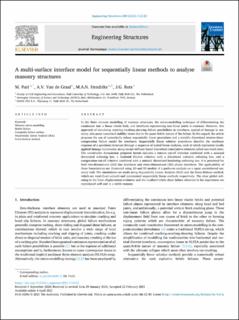| dc.contributor.author | Pari, Manimaran | |
| dc.contributor.author | Van de Graaf, de | |
| dc.contributor.author | Hendriks, Max | |
| dc.contributor.author | Rots, Jan G. | |
| dc.date.accessioned | 2022-02-23T09:58:50Z | |
| dc.date.available | 2022-02-23T09:58:50Z | |
| dc.date.created | 2021-08-31T13:57:41Z | |
| dc.date.issued | 2021 | |
| dc.identifier.citation | Engineering structures. 2021, 238, 1-15. | en_US |
| dc.identifier.issn | 0141-0296 | |
| dc.identifier.uri | https://hdl.handle.net/11250/2980940 | |
| dc.description.abstract | In the finite element modelling of masonry structures, the micro-modelling technique of differentiating the continuum into a linear elastic bulk, and interfaces representing non-linear joints is common. However, this approach of simulating cracking-crushing-shearing failure possibilities in interfaces, typical of damage in masonry, also poses numerical stability issues due to the quasi-brittle nature of the failure. In this regard, the article proposes the use of numerically robust sequentially linear procedures and a suitable discretised tension-shear-compression failure model for interfaces. Sequentially linear solution procedures describe the nonlinear response of a specimen/structure through a sequence of scaled linear analyses, each of which represents locally applied damage increments, using secant-stiffness based discretised constitutive relations called saw-tooth laws. The constitutive formulation proposed herein includes a tension cut-off criterion combined with a uniaxial discretised softening law, a Coulomb friction criterion with a discretised cohesion softening law, and a compression cut-off criterion combined with a uniaxial discretised hardening–softening law. It is presented for both two-dimensional (2D) line interfaces and three-dimensional (3D) planar interfaces. The applicability of these formulations are illustrated using 2D and 3D models of a pushover analysis on a squat unreinforced masonry wall. The simulations are made using Sequentially Linear Analysis (SLA) and the Force-Release method, which are total (load-unload) and incremental sequentially linear methods respectively. The clear global softening in the force–displacement evolution and the localised brittle shear failure observed in the experiment are reproduced well and in a stable manner. | en_US |
| dc.language.iso | eng | en_US |
| dc.publisher | Elsevier Science | en_US |
| dc.rights | Navngivelse 4.0 Internasjonal | * |
| dc.rights.uri | http://creativecommons.org/licenses/by/4.0/deed.no | * |
| dc.title | A multi-surface interface model for sequentially linear methods to analyse masonry structures | en_US |
| dc.type | Peer reviewed | en_US |
| dc.type | Journal article | en_US |
| dc.description.version | publishedVersion | en_US |
| dc.source.pagenumber | 1-15 | en_US |
| dc.source.volume | 238 | en_US |
| dc.source.journal | Engineering structures | en_US |
| dc.identifier.doi | 10.1016/j.engstruct.2021.112123 | |
| dc.identifier.cristin | 1930115 | |
| cristin.ispublished | true | |
| cristin.fulltext | preprint | |
| cristin.qualitycode | 2 | |

